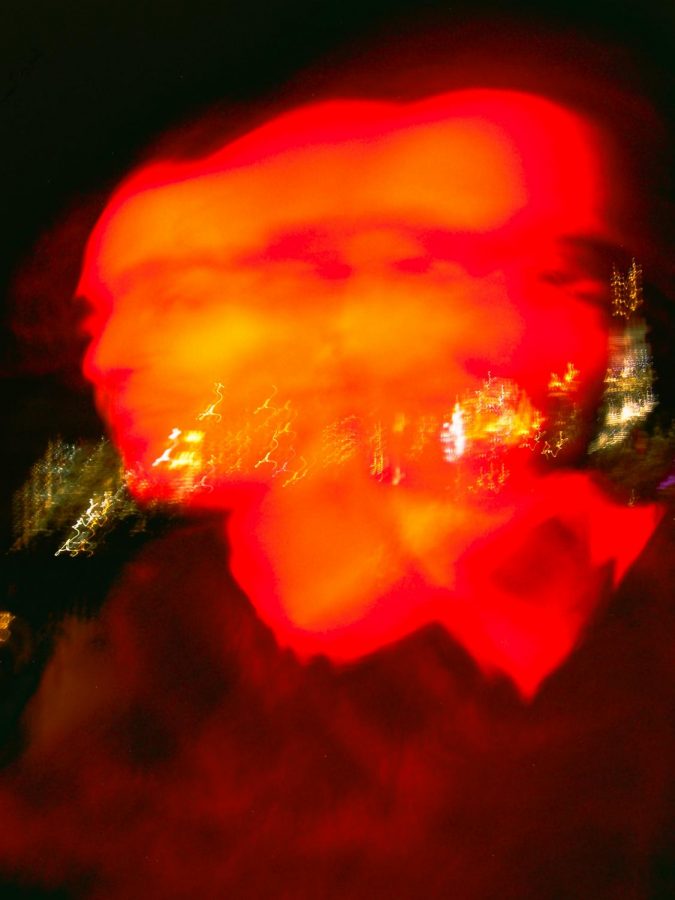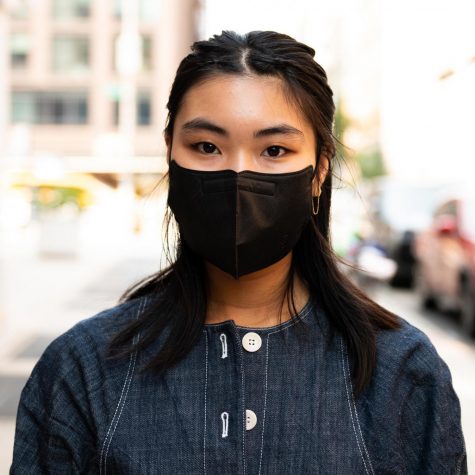Gallatin prof Julian Cornell on ’70s and ’80s punk, feuding with rockers, depressive aesthetics
(Staff Photo by Julian Hammond Santander)
November 24, 2021
This interview has been edited for length and clarity.
I was born in 1966, so the first time I ever went to a club I was 13 — that would have been ’79. I was familiar with this club because I had a friend in high school whose family owned it — A Space Odyssey, which is actually where “Saturday Night Fever” took place. I was in a band with the guy and his cousins.
I wasn’t in the party scene, but I was very into punk rock. I went to a lot of shows. I’ve been 6-foot-1 since I was 13, so I never got carded. I decided to get a fake ID when I was 14, but no one questioned it because I was 6-foot-1 with an ID that made me look angry. So that’s one of the reasons I got into the punk rock scene — I just got in everywhere! I didn’t have money for alcohol and I didn’t take drugs. I was simply into the punk rock scene.
I grew up mostly in Brooklyn. People from Brooklyn would go into Manhattan, but it was mostly working class and lower middle class people, and that’s really who caused it in the punk scene. One of the things that were very much a back-then thing was that there were a lot of people from the outer boroughs — not the wealthy parts — who would have a gathering place in the city for people who felt that they were outsiders — oftentimes, outsiders because of class.
Punk had such a loose definition, and there’s more to it than people think. People think of music when they think of punk, but it really has more of an attitude — especially during the time when the country was in the business of transforming to be a little bit more conservative. Punk was for the liberal working class, the lower class, the artsy kids. That’s where people tended to be more open-minded as opposed to the rock scene. There was this joke about them: They don’t go above 72nd Street because that was too far uptown, and really they just stayed below 14th Street for the most part.
The band I liked the most back then was the Ramones, and it’s because we identified with them because they were working-class guys from Queens. They were all from Forest Hills — well, except Tommy Ramone, who was originally from Brooklyn but then moved to Queens. Their songs were aggressive and loud. They weren’t very political — at least not then. Their songs were about feeling like an outsider, alienated, feeling like you didn’t belong.
They would play in Brooklyn, and that was a big difference between them and other bands. You’d have other groups in different parts of the country and they’d play at CBGB or Peppermint Lounge or The Reds. But the Ramones would play in Brooklyn a lot. There’s a place in Brooklyn called the Moors. The Ramones played there a lot, so I saw them a lot.
The only other band that played in Brooklyn was Blondie — actually, Chris Stein grew up two blocks from where I grew up in Brooklyn. He grew up on Ocean Avenue and East 20th Street, and I grew up on Ocean Avenue and East 21st. He was the legend of our part of Brooklyn, you know? He got out of this boring, crappy neighborhood and became a punk rock star!
We had to seek out music back then. We’d read British magazines like New Musical Express and The Enemy UK. There was also a lot of word of mouth: A lot of times, somebody would discover something, then make someone a cassette tape and pass it on to them. Because you weren’t going to hear the Ramones on the radio, you weren’t going to hear anything that we liked on the radio. We would also go to record stores. Record Runner was my favorite; so was Bleecker Bob’s.
There was a store called Crazy Eddie. There was a guy who worked there. And I remember — this was a pivotal experience — my sister asked me to pick up a Led Zeppelin, so I picked up this Led Zeppelin album. And I remember, I picked up Elvis Costello, his first album, based on the picture because I liked the cover. And I thought he looked really cool because he also looked nerdy. And I remember taking it to the front and the guy said, “Oh, you’re gonna love this. This guy is really cool. It’s punk-y, but not really. And it sounds really catchy, but the words are really great, and it’s really different. I’ve got some other things you’re gonna like.”
In Brooklyn, the music venues were all in rundown industrial areas because they were the only places in Brooklyn that weren’t zoned for it, with the exception of one place called Zappa’s. I saw a lot of people there, including this really popular underground band called The Fleshtones. I’ve seen them so many times because they would play in Brooklyn! Oh, they’re so loud though, I always say they’re the reason why I can’t hear.
We didn’t go to Madison Square Garden because that’s where all the rock bands went, and we thought it was too big for us. We very much thought we were standing on our principles by not going — we only went to small clubs. Back then, there was very much a cliquiness. Like, I still hate Journey with a burning passion. They’re an example of everything that is wrong with the world.
Those are the kinds of people where we were like, “Those people are losers.” There were also heavy metal people, but they were just into smoking pot and hanging out and listening to music, so we didn’t really have an issue with them.
We liked disco. Because of disco, it was more gender equitable. It brought discourse and change to sexual and gender identities — but this was before the Disco Sucks movement. We thought it became dumb after white people gentrified it. We called them squares.
In Manhattan, they also had Peppermint Lounge and Danceteria for New Wave and punk bands. They had the Knitting Factory for more experimental stuff. It’s in Brooklyn now, but it used to be in SoHo. And there’s another one called Limelight. Limelight was this old church that was actually really beautiful and it was converted into a club. It got a bad reputation in the ’80s, though, because it was a place a lot of people would go to buy drugs.
I was in a few bands. We played a few places, like CBGB. They had a very open policy, which was just like, I gave them my tape and if it was decent, they were like, “Yeah, come play.” Then there’d be certain nights where they’d give us maybe 20 minutes on a Monday, Sunday or Tuesday night. I think we played five songs.
We tried to have this combination of punkness and Talking Heads edginess and moodiness. My friend Tim’s family owned a club, so we played there a bunch of times. It was also known as the place Darren Aronofsky played — he’s just a few years behind me. We all lied about our ages and stuff like that. I was 17, but I said I was 18. We would make recordings and tapes and we would bring it around to clubs and perform on a Saturday night, where we were paid, like, nothing.
The longest band I was in was called Impossible, but we changed our name to The Impossible because it was a new wave thing. That was the one I was in longest because, you know, I’d be in so many bands. We would be together for like three months — you’d make music together, play a set together — then you’d be like, “Well, we suck,” then break up.
We wanted to kind of dress like the people in the scene that we would see on the weekends. And so very often I would go to the Lower East Side and would go to thrift stores to go shopping. Our fashion was trench coats and spiky hair. There was this store on Ninth Street. We would all go there to buy our shoes because it was one of the first places to have Doc Martens from England. We also had black jeans, ripped shirts — that sort of thing. I had short spiky hair, but I never did any piercings or tattoos, but my friends did. I had one earring and they had several nose piercings. The one thing I ever did was nail polish, but a lot of my friends would do nail polish, eye shadow, a whole look. My sister tried to look like Robert Smith from The Cure. She’d probably admit to that, too.
We tried to sound like The Replacements — they were a Minneapolis rock band. They were very much punk and very loose, like amateurish on purpose. And so most of the themes we had, it was about being sad, being depressed, seeing no future, which in retrospect was silly for me to think that way. Like, that’s so just depressing, isn’t it? But, you know, we were very anti-establishment. A lot of things like, “I’m afraid to die in a nuclear war” stuff too — that was a big theme. You know, we’d talk about people’s fakeness and plasticity.
When I listened to all the stuff I wrote, I was like, “Wow, this is really sad.” I don’t know why I did that. I’ve never had depression. I haven’t been that sad. I was listening to music and was just like, “Why am I acting so sad?” But it’s just because that’s what I was listening to at the time. We tried to emulate Blondie’s coolness, their detachment, and we’d copy the Ramones’ aggression.
We’d also go to Tompkins Square Park and Washington Square Park to observe people. We sort of just hung out and, you know — drank beer, participated in the resistance.
Contact Joey Hung at [email protected].

























































































































































